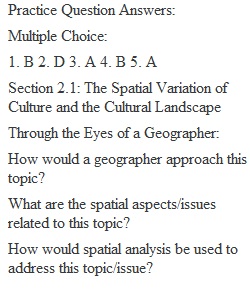


Q Section 2.1: The Spatial Variation of Culture and the Cultural Landscape Through the Eyes of a Geographer: How would a geographer approach this topic? What are the spatial aspects/issues related to this topic? How would spatial analysis be used to address this topic/issue? What are the where and why questions? How can this topic be studied and analyzed using the five themes of geography? Overview: Although the term culture is used often in our society, many people have difficulty defining it and often confuse and conflate it with race, nationality, and ethnicity. Geographers are interested in the spatial variation of all components of culture. Geographers study how cultures are shaped by the environment and how people of various cultures use, shape, and manipulate the environment. Beliefs and values change from one location to another on the earth’s surface. This spatial variation of culture may exist at smaller scales within a country, or at larger scales between world regions. Critical Thinking/Discussion Questions: 1. What is culture? What is your culture? How would you explain your culture to someone? How does a person become part of a culture? Can your culture change or is it stagnant? 2. Discuss culture with regard to human environment interaction. Does the physical environment influence culture? Does culture determine how people view and use the physical environment? 3. What are the two most important components of culture? How do beliefs and values shape how people treat one another and the physical environment? Practice Questions (Write Correct Answer in Blank): Multiple Choice: 1. ___ With regard to a society, the correct use of the term civilization implies: A) new B) structure C) modern D) Western 2. ___ The composite of human imprints on the earth’s surface is called: A) acculturated imprints B) possibilism C) human ecology D) cultural landscape 3. ___ The two most important components of culture are: A) values and beliefs B) food and music C) clothing and language D) recreation and art 4. ___ All cultural attributes and components are: A) genetic B) learned C) automatic D) based on heredity 5. ___ Typically, in the U.S., when a person from the majority culture commits an unacceptable act he is viewed as _____ by the majority culture: A) an individual acting outside of his cultural norms B) carrying out the beliefs of his culture C) an example of his culture D) representative of his culture True or False: 1. ___ Values and beliefs are the components of culture that shape who a person is and what a person does 2. ___ The terms culture and race have the same meaning. 3. ___ The physical environment has no impact on human cultures. 4. ___ A custom is a repetitive act of a group that becomes characteristic of the group. 5. ___ Cultures change over space and through time.
View Related Questions